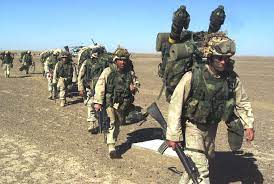On October 7, 2001, the United States launched a military campaign against the Taliban regime in Afghanistan. This marked the beginning of the War in Afghanistan, which was a response to the September 11, 2001, terrorist attacks on the United States. The attacks on September 11, orchestrated by the extremist group Al-Qaeda, resulted in the deaths of nearly 3,000 people and shocked the world. The U.S. government, under President George W. Bush, declared a "War on Terror" and sought to dismantle Al-Qaeda and remove the Taliban, who had been harboring the terrorist group. The Taliban had taken control of Afghanistan in the mid-1990s and imposed a strict interpretation of Islamic law. They provided a safe haven for Al-Qaeda, allowing the group to plan and carry out attacks from Afghan soil. In response to the Taliban's refusal to hand over Al-Qaeda leaders, the U.S. military, in collaboration with allied forces, initiated a military campaign to remove the Taliban from power. The initial phase of the military campaign, known as Operation Enduring Freedom, focused on targeting Taliban strongholds and disrupting Al-Qaeda's operations. U.S. forces, supported by airstrikes, launched a series of attacks on Taliban positions, infrastructure, and training camps. The campaign aimed to weaken the Taliban's grip on power and pave the way for the establishment of a stable and democratic government in Afghanistan. The U.S.-led coalition also worked closely with Afghan opposition forces, such as the Northern Alliance, who were fighting against the Taliban regime. The coalition provided air support and training to these local forces, bolstering their efforts to combat the Taliban and regain control of Afghanistan. The military campaign in Afghanistan faced various challenges. The rugged terrain, harsh weather conditions, and the Taliban's guerrilla warfare tactics made progress difficult. Additionally, the coalition faced the task of winning the hearts and minds of the Afghan people, who had suffered under Taliban rule. Over time, the conflict in Afghanistan evolved into a protracted war. The initial objective of removing the Taliban from power was achieved relatively quickly, but efforts to stabilize the country and establish a functioning government proved to be much more challenging. The war in Afghanistan became the longest war in U.S. history, with American troops remaining in the country for nearly two decades. The impact of the U.S. attacks on the Taliban in Afghanistan was significant. The military campaign disrupted Al-Qaeda's operations and severely weakened the Taliban regime. However, the conflict also had unintended consequences. The long-term presence of foreign troops, civilian casualties, and the challenges of nation-building created resentment and fueled insurgency in the country. October 7, 2001, marked a pivotal moment in the War in Afghanistan. The U.S. attacks on the Taliban were a direct response to the September 11 attacks and aimed to dismantle Al-Qaeda and remove the Taliban from power. The conflict that followed had far-reaching consequences, shaping the political, social, and security landscape of Afghanistan for years to come.
7 Oct, 2001 Afghanistan US Attacks Taliban
